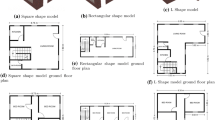Abstract
Many skyscrapers have installed wind turbine systems to use new renewable energy. In particular, building an integrated wind power generation system by installing a wind power generator inside a building is an attractive method to secure safe energy. However, most studies have dealt with the efficiency of wind turbines and the response effects of wind induced vibration; space preparation for wind turbine installations has not been sufficiently considered. This work reviewed the shapes of openings where wind turbines can be installed in skyscrapers, and the characteristics of wind induced vibration responses occurring in the building with changes in cross sectional area. Nine wind power models were constructed to carry out the experiment. According to the experimental results, wind speed varies with shape of opening in the order of C-type>S-type>R-type. Moreover, wind speed increases as the area is reduced.
Similar content being viewed by others

References
CONN Y, MARC Z, GUY B. Performance of a building integrated wind farm [C]// The 21st Conference on Passive and Low Energy Architecture. Eindhoven, The Netherlands, 2004: 19–22.
WATSON S J, INFIELD D G, BARTON J P, WYLIE S J. Modelling of the performance of a building-mounted ducted wind turbine [J]. Journal of Physics: Conference Series, 2007, 75: 1–10.
HEATH M A, WATSON S J, WALSHE J D. Estimating the potential yield of small building-mounted wind turbines [J]. Wind Energy, 2007, 10(3): 271–287.
BRAD C C, RICK R D. Integrating wind energy into the design of tall buildings: A case study of the houston discovery tower [C]// Wind Power Conference & Exhibition, Houston USA, 2008, 1: 144–155.
LEDO L, KOSASIH P B, COOPER P. Roof mounting site analysis for micro-wind turbines [J]. Renewable Energy, 2011, 36: 1379–1391.
MILANESE M, DE RISI A, LAFORGIA D. Experimental and fluid-dynamic analysis of a micro wind turbine in urban area [C]// Proceedings of Worlds Renewable Energy Congress, Sweden, 2011: 4106–4113.
MILANESE M, DE RISI A, LAFORGIA D. Performance optimization of building integrated-mounted wind turbine [J]. Applied Mechanics and Materials, 2013, 260/261: 69–76.
DUTTON A G, HALLIDAY J A, BLANCH M J. The feasibility of building-mounted/integrated wind turbines (BUWTs): Achieving their potential for carbon emission reductions [R]. Energy Research Unit: CCCLRC, 2005
RICHARD F, SMITH, SHAUN KILLA. 2007. Bahrain world trade center (BWTC): The first large-scale integration of wind turbines in a building [J]. The Structural Design of Tall Special Buildings, 2007, 16: 429–439.
Bahrain World Trade Center: News Update [EB/OL]. [2008-4-8]. (http://www.e-architect.co.uk/bahrain/bahrain_wtc_wind_turbines.htm). Iconic Bahrain towers reach further milestone (http://atkins-me.com/News.aspx?ItemNo=115)
RUSSEL F, SOM’s pearl river tower [EB/OL]. [2008-04-08]. http://archrecord.construction.com/features/digital/archives/0612casestudy-1.asp.
Frechette, Rogers and Gilchrist, Russell, Towards Zero Energy — A case study of the Pearl River Tower [C]// CTBUH 8th World Congress, Guangzhou, China, 2008: 1–11.
JEARY A P. Perception of vibration tests in a tall building [J]. Journal of Wind Engineering and Industrial Aerodynamics 1988, 41–44: 105–116.
AIJ (Architectural Institute of Japan). Recommendations for loads on buildings [R]. Tokyo, Japan: Architectural Institute of Japan, 2004.
ISO-6897. Guidelines for the evaluation of the response of occupants of fixed structures, especially buildings and off-shore structures to low frequency horizontal motion(0.063 to 1Hz) [S].
Author information
Authors and Affiliations
Corresponding author
Additional information
Foundation item: Project(2011-0028567) supported by the National Research Foundation of Korea
Rights and permissions
About this article
Cite this article
You, Kp., You, Jy. & Kim, Ym. Wind response of high-rise building in diversified inlets to construct wind turbine system on roof. J. Cent. South Univ. 21, 4395–4403 (2014). https://doi.org/10.1007/s11771-014-2440-3
Received:
Accepted:
Published:
Issue Date:
DOI: https://doi.org/10.1007/s11771-014-2440-3



